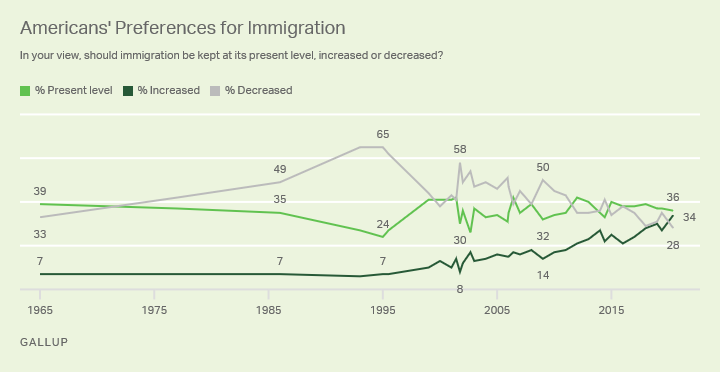Each year in June, the Gallup organization does a national poll on attitudes toward immigration. Here's the answer to a basic question: should immigration be kept at its present level, increased, or decreased?
As you can see, from the 1960s up through the mid-1990s, the share who wanted to increase immigration was quite low at about 7%. In 1995, 65% wanted to decrease immigration.

But opinions on immigration have shifted dramatically in the last 25 years and perhaps especially since around 2010. The "present level" group has often been roughly one-third of the total over time, with some fluctuations. But the share wanting "increase" has been rising over the last 25 years,and in the early June survey it came in higher than the share wanting "decrease."
One reason for the shift, I suspect, is that the foreign-born share of the US workforce has been rising during this period. Moreover, the foreign-born workers as a group have become more likely to have college degrees. One additional factor is that the rise number of immigrants without legal status flattened out back in the 2007-2009 recession, and the number of people in this category hasn't been rising since then. A recent Congressional Budget Office report provides a data-based look at "The Employment of Foreign-Born People" (June 2020) wrote:
The foreign-born population of the United States was 46 million in 2018, representing 1 out of every 7 people. Twenty years earlier, in 1998, 1 out of every 10 people had been born abroad. Over the past two decades, the foreign-born population increased by 61 percent, outpacing the 13 percent increase in the native-born population. A key component of that growth was the increase in the number of foreign-born people with legal status; by CBO’s estimate, that number grew from 20 million, or 72 percent of foreign-born people, in 1998 to 35 million, or 76 percent of foreign-born people, in 2018. At least 90 percent of foreign-born people with legal status were naturalized citizens or lawful permanent residents, according to data from the Department of Homeland Security; the rest had temporary legal status usually associated with study or work. The numbers of foreign-born people both with and without legal status grew between 1998 and 2007, according to CBO’s estimates, but most of the growth thereafter was among people with legal status.Moreover, the CBO report shows an ongoing shift toward higher education levels for the foreign-born in the last couple of decades.
This shift has been widely noted. As one example, a National Science Foundation report pointed out earlier this year.
Foreign-born workers—ranging from long-term U.S. residents with strong roots in the United States to more recent immigrants—account for 30% of workers in S&E occupations. The number and proportion of the S&E workforce that are foreign born has grown. In many of the broad S&E occupational categories, the higher the degree level, the greater the proportion of the workforce who are foreign born. More than one-half of doctorate holders in engineering and in computer science and mathematics occupations are foreign born.I'm sure that part of the shift toward encouraging more immigration is less about the issue itself, and is just politics: in this case, a pushback against President Trump's anti-immigration rhetoric. For example, Democrats rather abruptly began to increase their support of free trade after Trump took office threatening protectionism early in 2017. But these underlying shifts in attitudes toward immigration, along with shifts in numbers and skill levels, didn't just start in the last few years: they have been evolving over time.